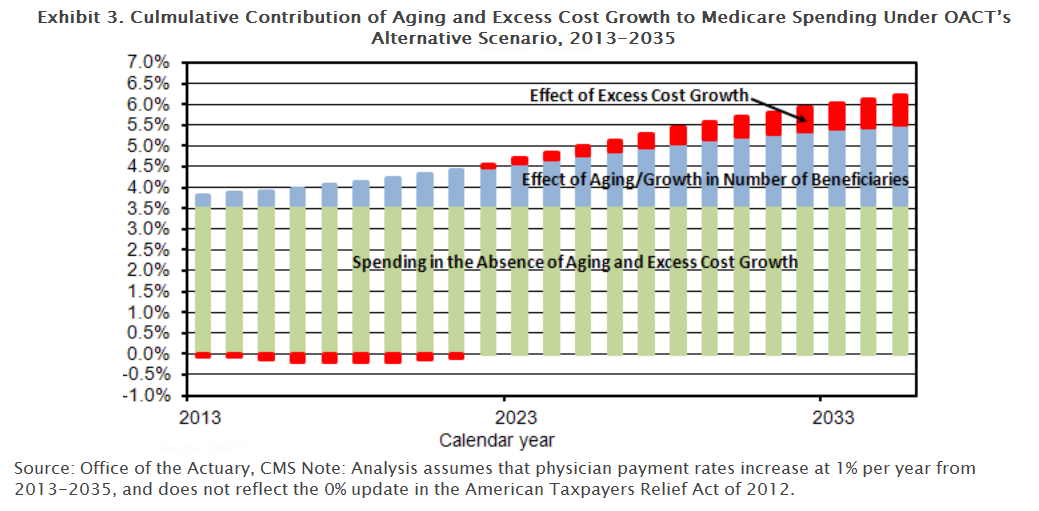Concord Coalition: It's Not Just a Health Care Problem
We've said frequently on this blog that controlling health care spending will be a crucial part of putting the debt on a sustainable path. After all, federal spending on health is expected to grow from 4.9 percent of the economy in 2013 to 6.4 percent in 2023 under our realistic baseline and to much higher levels thereafter. While rising health care costs are certainly a major driver of the future deficits, the aging of the population is actually a larger debt driver over the next three or so decades.
A recent post from Joshua Gordon, policy director of the Concord Coalition discusses the issue of rising health care costs. He explains:
Spending can grow either because more people are getting their health care services paid for -- a growth in beneficiaries -- or because those services are becoming more costly and numerous. In the political debate, when people use the phrase “it is a health care problem,” they usually are not arguing that the federal government provides health insurance for too many people. Instead they are trying to say that the problem is the growth in the cost of health care from too many services at too high a price.
This growth, either called "health care inflation" or the even more technical term "excess cost growth," is the bogeyman of the "health care problem" story. The story is that our nation’s health care system doesn’t do a good job at keeping health care costs down. That the best measurement of that failure is the per-person growth rate above the per-person rate of growth in the economy (GDP) -- the "excess" in the term "excess cost growth." And, that this explains why federal budget spending is projected to rise so dramatically in the future.
But given the recent slowdowns in health care cost growth, Gordon notes that this factor isn't the dominant driver in the increase in health care spending over the next decade. Rather, it is demographics; the retirement of the "Baby Boom" generation will increase the number of seniors served by Medicare by 17 million in ten years. Gordon uses a chart from the Medicare Actuary that shows that excess health care cost growth will make little contribution to the increase in health care spending in the next decade, and demographic factors will dominate for the next two.

Source: Richard Kronick and Rosa Po
Aging will, of course, be the dominant factor in the growth of Social Security spending as well, although Medicare is projected to grow by more over the long term. It will also be somewhat of a factor in the growth of other health spending, particularly Medicaid.
At least for Social Security and Medicare, one way to mitigate the factor of aging is to adjust the eligibility ages for these programs. This would ensure that both program's resources are targeted towards the population most likely to need them (the "old-old"). Such a change would also be beneficial for the economy by increasing the labor supply and near-retirees' savings, lessening the strain of the demographic shift on the budget and economy overall.
Although aging will be the bigger factor in terms of entitlement spending growth in the next few decades, excess cost growth will become the dominant factor over the longer run. As the CBO said in its latest long-term budget outlook:
Over the longer term, however, the situation changes. Beyond 2037, the age profile of the population will stabilize, and the effect of aging on the programs’ spending growth will diminish. As a result, excess cost growth accounts for an increasing share of the total projected growth in spending for the health care programs and Social Security and becomes the dominant factor in explaining the growth of spending on the health care programs alone.
Thus, health care reforms must be considered in budget negotiations, as the United States spends far more on health care per capita than any other developed country, and there are many health care reform options that could increase efficiency, federal savings, and even savings for beneficiaries. But more will need to be done than just controlling health care costs. We will need to make changes to the budget that directly account for both aging and health care cost growth and make up for those factors in other ways through further changes to spending and revenue.
The full post can be found here.


